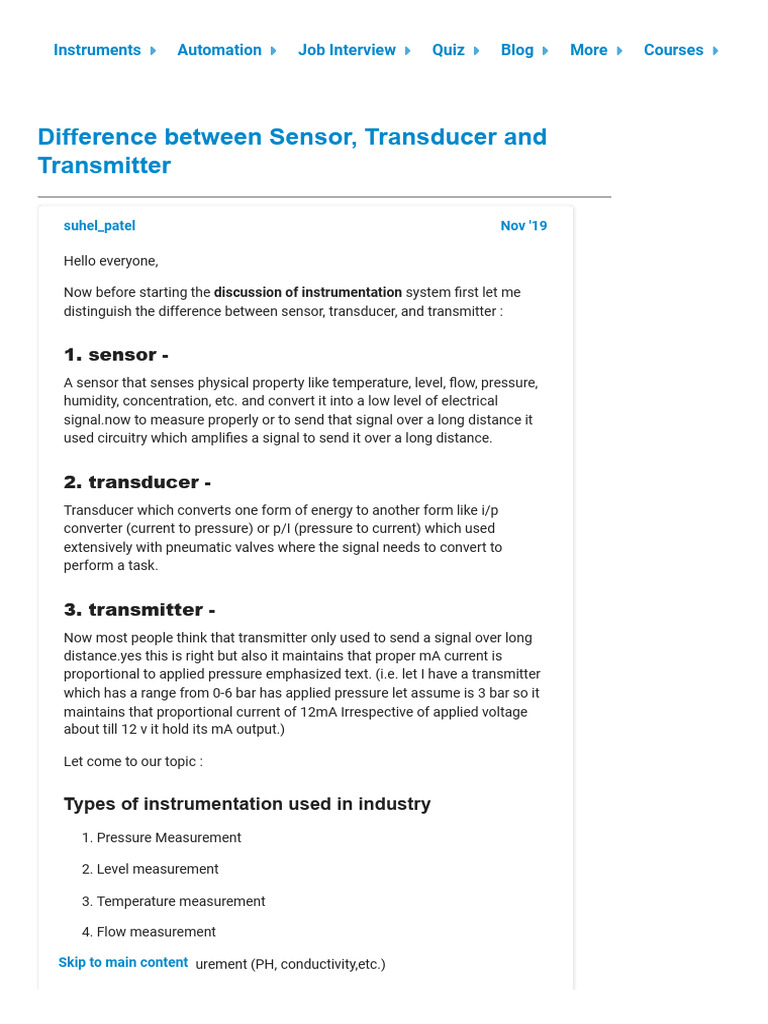The intricate world of measurement technology often presents a convoluted landscape, populated by various terminologies such as sensors and instruments. While they are frequently used interchangeably in casual conversation, a closer examination reveals a spectrum of differences that are not only critical for professionals in the field but also captivating for those intrigued by the underlying principles of technology. By unpacking these distinctions, we foster a deeper understanding of measurement methodologies and their implications across numerous applications.
To begin, let us delineate the fundamental definitions of a sensor and an instrument. A sensor is a device that detects changes in physical, chemical, or biological conditions and converts this data into an electrical signal. Essentially, sensors are the sensory organs of technology, responding to various stimuli—light, heat, pressure, or chemical composition. In contrast, an instrument is a broader term that encompasses any device designed to measure, analyze, or manipulate physical quantities. Instruments often integrate multiple sensors to provide a comprehensive analysis or actionable output, thereby serving a more extensive purpose than a sensor alone.
The distinction begins to crystallize when we consider the functionality and utilization of these devices. Sensors operate at the input level; they are the gateways through which environmental stimuli are transformed into quantifiable signals. For instance, a temperature sensor might produce a voltage output that corresponds to a specific temperature reading. This data, albeit raw and unprocessed, forms the foundation upon which further analysis can occur.
Instruments, on the other hand, synthesize the signals derived from sensors and employ various mechanisms—mechanical, electronic, or digital—to yield refined measurements or valuable insights. Instruments, therefore, can be viewed as complex systems that often include multiple components, such as analog-to-digital converters, display units, and processing algorithms, which work collectively to produce meaningful information. For example, a digital multimeter not only contains sensors to detect voltage or current but also integrates circuitry to interpret this information, enabling users to view the results in an easily digestible format.
Moreover, the nature of data processing diverges significantly between sensors and instruments. Sensors provide raw data that necessitates further manipulation to be useful. An actuary measuring temperature using a thermocouple must interpret the voltage output, often engaging in additional calculations or calibrations to arrive at an accurate temperature reading. Conversely, instruments encapsulate a myriad of processing functions that streamline this task, transforming raw data into readily interpretable results. This presents a vital aspect of usability—while sensors require expertise to extract information, instruments afford accessibility to users with varying levels of technical proficiency.
The operational environments of sensors and instruments also merit discussion. Sensors often thrive in conditions that might be less favorable for instruments. For instance, in industrial settings where continuous monitoring is essential, sensors maintain performance under harsh conditions, such as extreme temperatures or corrosive environments. Instruments may, however, require more controlled environments to function optimally, as their reliance on additional electronic components heightens susceptibility to interference from external factors, such as electromagnetic fields or vibrations.
Furthermore, the technological evolution and future trends illustrate a fascinating interplay between sensors and instruments. With the advent of the Internet of Things (IoT) and smart technologies, sensors are experiencing exponential advancements, enabling them to communicate and share data seamlessly. This evolution has led to the proliferation of sensor networks, where multiple sensors collaborate in real-time to enhance situational awareness. Instruments are evolving in tandem, adapting to integrate these sensory capabilities, resulting in increasingly sophisticated instruments that leverage massive datasets for even more nuanced measurements. This symbiotic relationship promises to redefine the landscape of measurement technology in the coming years, prompting a reconsideration of traditional boundaries between sensors and instruments.
It is equally important to explore the applications that differentiate these components. Industries such as automotive, healthcare, and manufacturing deploy sensors for specific tasks such as monitoring critical parameters—engine temperature, blood glucose levels, or environmental pressures. Instruments, however, encompass a vast array of tools from oscilloscopes to spectrometers, facilitating not just the acquisition of data but also the analysis and interpretation of multifaceted information necessary for decision-making processes. This differential utility dramatically affects how professionals approach problems ranging from routine monitoring to complex diagnostic applications.
The implications of these distinctions manifest in the academic realm as well. Scholars engaged in research often require precise definitions and understandings of instrumentation. The differentiation between sensors and instruments becomes critical to formulating hypotheses, designing experiments, and analyzing results. A robust understanding of these concepts not only augments the validity of scientific inquiry but also inspires innovative methodologies that enhance knowledge within various scientific disciplines.
In conclusion, while sensors and instruments are integral to the realms of measurement and analysis, they occupy distinct roles shaped by their functionalities, operating environments, and applications. Sensors, as pivotal data gatherers, lay the groundwork for insight, whereas instruments serve as the facilitators of comprehensive analysis and interpretation. This dichotomy invites curiosity into how emerging technologies continue to bridge the gap between these components, heralding promising advancements in measurement capabilities and setting the stage for new explorations in technology-augmented understanding of the world around us.










